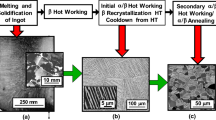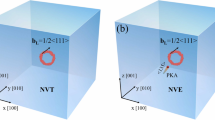Abstract
The temperature dependence of the long range (internal) and thermally activated components of the flow stress have been measured by a stress relaxation technique over the temperature range 200 to 550 K in α titanium containing five different levels of oxygen. In addition, the dislocation arrangements have been studied using thin foil electron microscopy techniques. In the higher oxygen materials it has been found that a transition from wavy to planar slip occurs towards lower temperatures. The internal stress varies more strongly with temperature than would be predicted by the temperature dependence of the elastic modulus; simultaneously, the thermally activated component of the flow stress (t*) obtained as the difference between the flow and internal stresses, goes through a maximum at the temperature where the internal stress (Tint) becomes strongly temperature dependent. An increase in t* and rise of Tint accompany the onset of planar slip.
Similar content being viewed by others
References
H. Conrad:High Strength Materials, p. 436, John Wiley and Sons, 1965.
J. E. Dorn and J. B. Mitchell:High Strength Materials, p. 510, John Wiley and Sons, 1965.
P. P. Tung and A.W. Sommer:Met. Trans., 1970, vol. 1, p. 947.
J. C. M. Li:J. Can. Phys., 1967, vol. 45, p. 493.
G. B. Gibbs: C.E.G.B. Report RD/B/N-416.
M. J. Blackburn and J. C. Williams:Trans. TMS-AIME, 1967, vol. 239, pp. 287–88.
R.E. Curtis, R. R. Boyer, and J. C. Williams:Trans. ASM, 1969, vol. 62, p. 457.
K. R. Evans:Trans. TMS-AIME, 1968, vol. 242, p. 648.
H. Conrad:Acta Met., 1966, vol. 14, p. 1631.
H. Conrad:J. Can. Phys., 1967,vol.45,p. 581.
H. H. Conrad and R. Jones:The Science and Technology of Titanium, p. 489, Pergamon Press, 1970.
K. V. Ravi and R. Gibala:Met. Trans., 1971, vol. 2, p. 1219.
F. Kocks: Presented at the Fall Meeting of AIME, Philadelphia, Pa., Oct., 1969.
C.N. Ahlquist:Scripta Met., 1971, vol. 5, p. 185.
Author information
Authors and Affiliations
Additional information
P. P. TUNG, formerly Graduate Student, University of California at Los Angeles
An erratum to this article is available at http://dx.doi.org/10.1007/BF02645632.
Rights and permissions
About this article
Cite this article
Williams, J.C., Sommer, A.W. & Tung, P.P. The influence of oxygen concentration on the internal stress and dislocation arrangements in α titanium. Metall Trans 3, 2979–2984 (1972). https://doi.org/10.1007/BF02652870
Received:
Published:
Issue Date:
DOI: https://doi.org/10.1007/BF02652870




